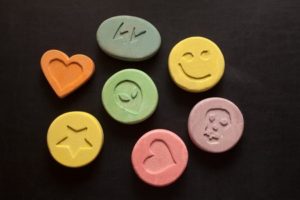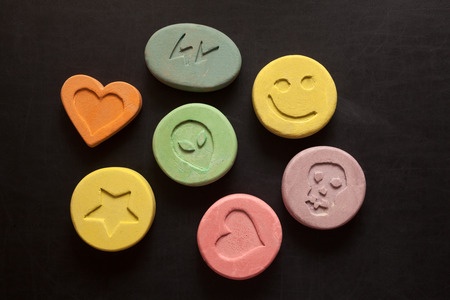
There are a handful of names for 3,4-methylenedioxymethamphetamine (MDMA), including: E, X, XTC, Rolls, Adam, Molly and Ecstasy. The pro-drug website Erowid noted it is one of the most popular recreational psychoactives, known for its euphoric, stimulant and empathogenic (feelings of oneness, emotional openness, empathy or sympathy) effects. This last effect indicates it has a past and current history of use in psychotherapy. But when you see a warning that, “Ecstasy tablets are notoriously impure, often containing chemicals other than MDMA,” be forewarned you may not be actually using MDMA.
The MDMA timeline on Erowid indicated MDMA was first synthesized and patented by Merck Pharmaceuticals in 1912. And the first animal testing of MDMA occurred at Merck in 1927. An article titled, ‘The Origin of MDMA (“Ecstasy”)’ indicated the 1912 Merck patent was a procedural patent, meaning MDMA was a precursor compound for another therapeutic and was not isolated as a drug in its own right. “Obviously, it was never intended for sale. MDMA was not tested pharmacologically in 1912.” The 1927 experiments were only aimed at exploring the potential pharmacological actions of MDMA. You can also read about MDMA and it history here on Wikipedia.
The first scientific paper on MDMA wasn’t published until 1960—in Polish. Alexander Shulgin resynthesized MDMA in 1965 while working at Dole Pharmaceuticals, but did not try it on himself at this time. Between 1967 and 1975 there were reports of small underground batches of MDMA being used recreationally, but Erowid said it had no clear documentation of its use before the mid 1970s. It didn’t become widely available as a street drug until around 1977.
Schulgin first heard of the psychoactive effects of MDMA from a student, and he tried it himself in September of 1976. He then reported on MDMA at a conference in December of 1976. Along with David Nichols, Schulgin wrote and published a report on the drug’s psychoactive effects in 1978. They described MDMA as inducing “’an easily controlled altered state of consciousness with emotional and sensual overtones”’ comparable ‘to marijuana, to psilocybin devoid of the hallucinatory component, or to low levels of MDA.’” Schugin referred to MDMA as “window”, because it allowed users to strip away habits and perceive the world clearly.
Because of its disinhibiting effects, Schulgin thought it could be useful in psychotherapy, so in 1977 he gave some to Leo Zeff, a psychotherapist. Zeff was so impressed with the effects, he came out of semi-retirement to promote its therapeutic use. Reportedly, he eventually trained an estimated four thousand therapists in the therapeutic use of MDMA. Zeff referred to MDMA as “Adam”, as he saw it putting users into a state of “primordial innocence.” It is believed that MDMA eliminates fear and increases communication in therapeutic users.
Concerned that MDMA would become an illegal substance like LSD and mescaline, early advocates tried unsuccessfully to restrict the available information and use of MDMA while they conducted informal research on its properties. By the late 1970s, there was a small recreational market for MDMA. By the early 1980s, it began to take hold as a “club drug” in places like Studio 54.
In 1984, Michael Clegg put together some financial backing, coined the term “Ecstasy” for MDMA, and mass-produced it in a Texas lab. “Ecstasy parties” were advertised at bars and discos. MDMA use quickly became a common sight on college campuses. “By May 1985, MDMA use was widespread in California, Texas, southern Florida, and the northeastern United States.”
Concern over the recreational use of MDMA resulted in its temporary placement as a Schedule I controlled substance on July 1, 1985. As a result of a hearing challenging the placement of MDMA as a Schedule I controlled substance, it was removed from its Schedule I status because of an improper procedure when it was originally scheduled on December 22, 1987. Within a short period of time, the DEA administrator reclassified MDMA as Schedule I, and it was permanently placed as a Schedule I controlled substance on March 23, 1988.
Ecstasy has remained a common recreational substance, particularly at dance clubs and raves. But it also persisted as a potential psychotherapeutic agent. The non-profit organization MAPS—Multidisciplinary Association for Psychedelic Studies—is currently funding clinical trials of MDMA as a “tool to assist psychotherapy” in the treatment of PTSD. Rick Doblin, the executive director of MAPS, founded it in 1986. His pre-MAPS organization, Earth Metabolic Design, held a conference on MDMA in March of 1985, in the midst of the fight over whether MDMA should become an illicit controlled substance.
MAPS is undertaking a roughly $20 million plan to make MDMA into a Food and Drug Administration (FDA)-approved prescription medicine by 2021, and is currently the only organization in the world funding clinical trials of MDMA-assisted psychotherapy. For-profit pharmaceutical companies are not interested in developing MDMA into a medicine because the patent for MDMA has expired. The idea of using MDMA to assist psychotherapy of any kind for any specific clinical indication has long been in the public domain.
The development of psychoactive substances like MDMA, LSD, Ibogaine and Ayahusca as psychotherapeutic “tools” has gained momentum in recent years. In part, this is because of the growth of concerns over the adverse effects and long-term use of FDA approved medications like antidepressants and antipsychotics. MAPS supports research into the therapeutic use of each of the above-named psychoactive substances. The following quote illustrates how MAPS presents the therapeutic benefits of MDMA-assisted psychotherapy: “MDMA is only administered a few times, unlike most medications for mental illnesses which are often taken daily for years, and sometimes forever.”
Along with Erowid, MAPS cautions that substances sold as “Ecstasy” or “molly” may not be pure MDMA. “Substances sold on the street under these names may contain MDMA, but frequently also contain unknown and/or dangerous adulterants.” The rise of novel or new psychoactive substances (NPS) such as “bath salts” has meant that many partygoers who think they are using MDMA aren’t. Media outlets such as Newsweek and The Fix have reported on a recently published study in the journal Drug and Alcohol Dependence that tested hair samples from ecstasy users for the presence of NPS. The lead author of the study, Joseph Palmer, said in an NYU press release on his research that:
Given the sharp rise in poisonings and recent deaths at dance festivals related to ecstasy use, research was needed to examine whether nightclub/festival attendees who use ecstasy or Molly have been unintentionally or unknowingly using “bath salts.”
The researchers surveyed young adults outside of nightclubs and dance festivals in the summer of 2015 about their use of ecstasy and other drugs. The participants were asked if they had knowingly used any of a list of more than 35 NPS; and whether or not they had knowingly used ecstasy, MDMA or “molly.” Then they were asked if they would submit a lock of their hair for the researchers to test for NPS. “We collected hair samples from about a quarter of the survey sample to be tested for novel drugs.”
A lot of people laughed when they gave us their hair saying things like “I don’t use bath salts; I’m not a zombie who eats people’s faces.”
However, the researchers found that among individuals who reported they had not knowingly used bath salts or some unknown substance, 40% tested positive for “bath salts” and other NPS. Among participants reporting they had used ecstasy, half the samples tested positive for MDMA and half tested positive for bath salts and other NPS. One sample tested positive for alpha-PVP, flakka.
Ecstasy wasn’t always such a dangerous drug, but it is becoming increasingly risky because it has become so adulterated with new drugs that users and the scientific community alike know very little about. . . . Users need to be aware that what they are taking may not be MDMA.





